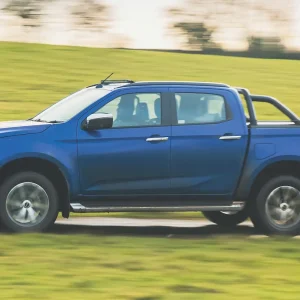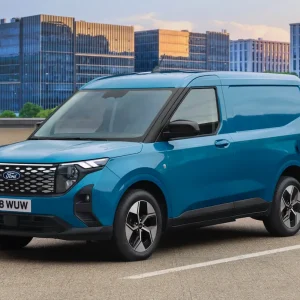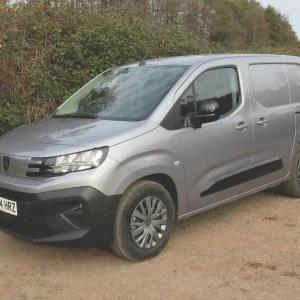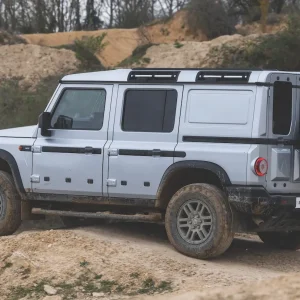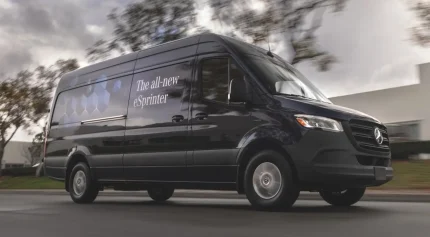
Mercedes-Benz’s introduction of its first electric Sprinter back in 2020 proved to be something of a false start.
The original eSprinter had an 85kW motor paired with a 55kWh battery pack. It borrowed tech from the eVito of the time – which was also an electric van based on the diesel version – and it lacked the high-end functions you come to expect from a Mercedes, like its MBUX infotainment system. Its biggest disadvantage, however, was an anxiety-inducing range of just 95 miles. In stark contrast, the 2024 iteration of the eSprinter boasts a claimed range of up to 277 miles.
Rather than the one-size-fits-all approach of before, the new model is available with two battery sizes (81 and 113kWh), two power outputs (100 or 150kW), two lengths (L2 and L3) and two bodystyles (panel van and chassis cab). Mercedes says a smaller 56kWh battery will be made available by special request. The new eSprinter is produced in what Mercedes describes as “net-carbon-neutral production plants” in Düsseldorf and Ludwigsfelde in Germany.
The flagship eSprinter with the 113kWh battery, tested here in right-hand drive mode, is only available in the L3 body size. Weighing 4.25-tonnes, drivers without ‘grandfather rights’, acquired through passing their test before 1997, will need to undertake five days training to be street legal. The 81kWh battery, with a range of 162 miles, will be offered at 3.5-tonnes.
On the road
The eSprinter comes with three driving modes, Maximum Range, Economic and Comfort, which control engine power, engine torque and climate control. As you’d expect, Maximum Range squeezes the most out of the battery by restricting the power on tap by 20%. On a mild day with a moderate load on board this is the programme to choose. Economic mode is the happy medium to suit most applications while Comfort provides access to the full 150kW (201hp) available and does not restrict climate control functions.
Performance is impressively brisk in this mode, which is the one to choose when carrying a load weighing close to the 1,072kg limit.
Mercedes also offers a wide choice of regenerative braking modes with the eSprinter, which are selected via paddle levers on the steering wheel. These range from D-, which delivers the least recuperation and is ideal for coasting at higher speeds, to D++, which provides the stiffest retardation and makes one-pedal driving the best way to negotiate urban missions.
With the new eSprinter, Mercedes has added the D Auto mode into the mix. The driver can select it by holding the paddle for two seconds. Mercedes claims D Auto uses the radar-sensor to select the best mode based on the traffic or the terrain and says it is a good choice for drivers unfamiliar with getting the best economical performance out of electric vans. The idea is that if you’re approaching stationary traffic and you lift off the accelerator it will automatically select the most severe mode to regenerate the battery as much as possible and cut speed. Conversely, if you’re going up an incline and you lift off, it will select D++ where there is no recuperation, allowing you to coast without losing unnecessary momentum.
In practice we found D Auto did not always select the mode best suited to driving conditions, particularly in heavy traffic where maximum retardation was required. Nevertheless, it is a worthwhile addition and one which Mercedes says can be refined over time.
Interior
Inside, the eSprinter now gets the full MBUX system with digital dash and infotainment system. The 10.25in touchscreen is standard on all models and comes with DAB radio, Bluetooth and wireless smartphone connectivity. We found the screen’s landscape design was easy to use but did not provide the best view of the satnav map.
Standard equipment on the entry-level Pro model includes heated electric mirrors, multifunction steering wheel, heated front driver seat, air-conditioning and a reversing camera. Upgrading to the Select model gives the van front and rear mud flaps, a leather steering wheel and an upgraded driver’s seat. There are also LED headlights and automatic high beam headlight assistance.
Safety provision is comprehensive and includes: active brake assist, active lane keeping assist, blind spot assist, drowsiness warning, intelligent speed assist with cruise control, Mercedes-Benz emergency call system, an anti-theft protection package with a double-lock system and on panel van models, a reversing camera.
| Model | Mercedes-Benz eSprinter 113kWh |
| Price (ex VAT, inc PIVG) | £71,920 |
| Price range (ex VAT, inc PIVG) | £54,915-71,920 |
| Insurance group | tbc |
| Warranty | 3yrs/unlimited mls (battery capacity 8yrs/100,000mls) |
| Service intervals | 1yr/40,000mls |
| Load length | 4307mm |
| Load width (min/max) | tbc/1787mm |
| Load bay height | 2009mm |
| Gross payload | 1072kg |
| Load volume | 14.0m3 |
| Engine size/power | 150kW electric motor 204hp |
| Range | 270 miles |
| CO2 | 0g/km |
| On sale | May 2024 |
| Key rival | Ford E-Transit |
| Verdict | With power, range and practicality all improved, the new eSprinter is a big step up compared to its predecessor. |
| Score | 8/10 |

